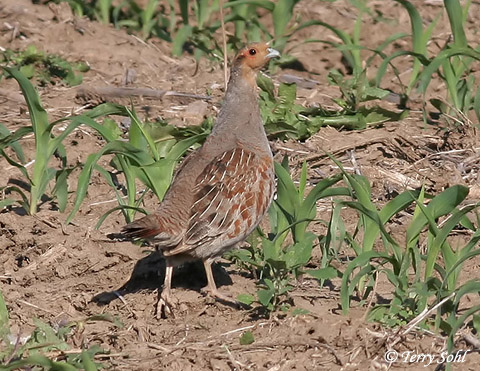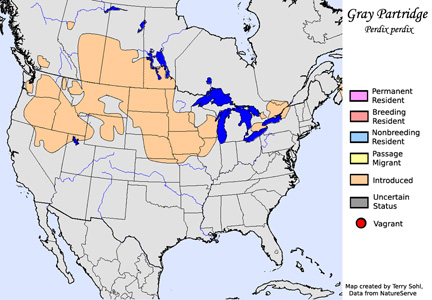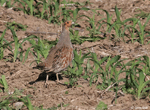Gray Partridge
Perdix perdix
| Length: 12 inches | Wingspan: 18 - 22 inches | Seasonality: All Seasons |
| ID Keys: Grayish-brown overall, orangish face and throat, dark chestnut belly patch | ||
 The
Gray Partridge is native to Eurasia but was introduced into North America in
the early 1900's as a game bird. They have become well established,
and can be found through much of the upper Great Plains and parts of the
West. The agricultural lands of eastern South Dakota are an ideal
habitat, providing shelter along fencerows and other brushy areas and also a
readily available winter food source in waste grain.
The
Gray Partridge is native to Eurasia but was introduced into North America in
the early 1900's as a game bird. They have become well established,
and can be found through much of the upper Great Plains and parts of the
West. The agricultural lands of eastern South Dakota are an ideal
habitat, providing shelter along fencerows and other brushy areas and also a
readily available winter food source in waste grain.
Habitat: Does well in agricultural land where fencerows and other thicker cover are available. Stubble fields of grain crops are a favorite location during the winter months. Can also be found in pastures and grasslands.
Diet: Feeds heavily on seeds and grain, relying heavily on waste grain (corn, sunflowers, wheat) during the winter. Also feeds on insects during the summer months, and green leaves, shoots, and buds.
Behavior: Primarily forages on the ground, although will also take insects and seeds from standing vegetation. They are usually found in small groups, but can be found singly or in pairs early in the breeding season in spring.
Nesting: May through July
Song: Low harsh kyerr-r-reck
Migration: Generally non-migratory, although with some local movement.
Interactive eBird map: Click here to access an interactive eBird map of Gray Partridge sightings
Similar Species: Chukar
Conservation Status: Still widespread and common in much of their normal range, but with numbers probably below historical highs from the middle of the 20th century.
Further Information: 1) USGS Patuxent Bird Identification InfoCenter, Gray Partridge
2) Audubon Guide - Gray Partridge
Photo Information: June 10th, 2008 - Minnehaha County, South Dakota - Terry Sohl
Additional Photos: Click on the image chips or text links below for additional, higher-resolution Gray Partridge photos.
| Click on the map below for a higher-resolution view |
 |
| South Dakota Status: Uncommon permanent resident throughout the state, except rare in the southwestern part of the state. |
Additional Gray Partridge Photos
Click for a higher-resolution version of these photos

